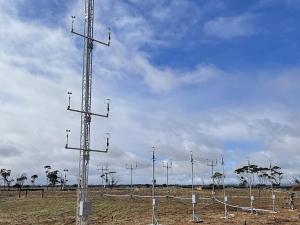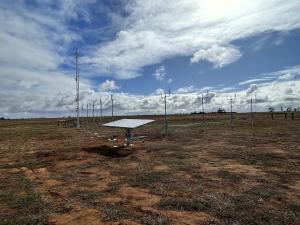Heliostat Wind Loads
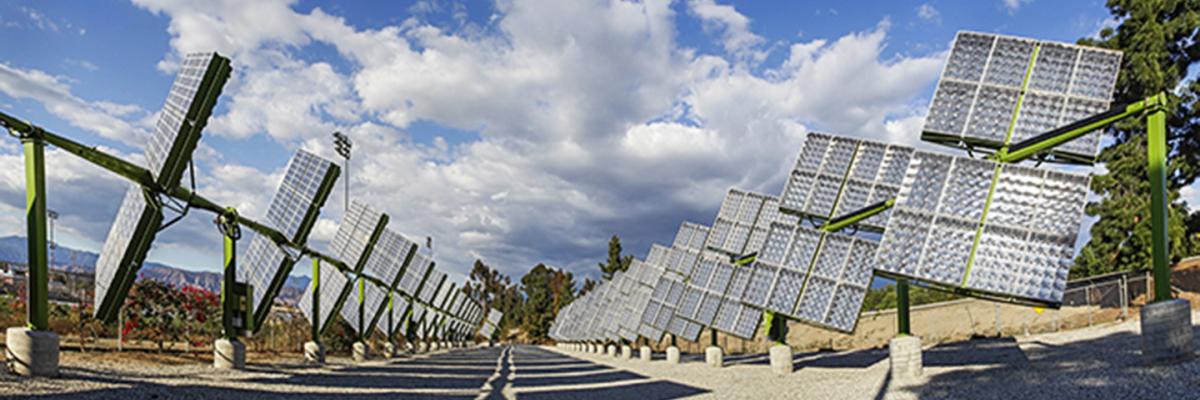
The heliostat wind load and aerodynamics research group aims to improve our current understanding of the turbulence characteristics in the atmospheric boundary layer (ABL) through the use of detailed experimental measurements in a large-scale wind tunnel.
Developing methods for wind load reduction can assist heliostats to be designed from lighter materials that would lower the manufacturing and installation costs of the heliostat field in a concentrating solar thermal (CST) power tower (PT) system.
The heliostat wind load and aerodynamics research group is continually looking for potential industrial/research collaborators, as well as potential PhD students, both locally and globally. If you would like to discuss potential collaboration, please do not hesitate to contact us.
-
Background
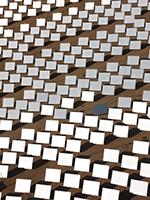
The motor drives, support structure and mirror of a heliostat account for up to 80% of the heliostat capital cost (Kolb et al. 2011), but this can be reduced with an accurate estimation of the wind loading on these components to maintain the structural integrity while achieving good optical performance (Pfahl et al. 2017).
Heliostats are designed to maintain structural stiffness during operation at different elevation angles and with sufficient structural strength to withstand the maximum wind loads during high-wind conditions when aligned parallel to the ground in the stow position. This requires a detailed understanding of the turbulent phenomena in the lowest 10 m of the atmospheric surface layer where heliostats are positioned. The research outcomes would allow the development of reliable engineering tools to predict and further optimise the wind loads on heliostats in various configurations.
References
Kolb, G.J., Ho, C.K., Mancini, T.R. & Gary, J.A. (2011), Power Tower Technology Roadmap and Cost Reduction Plan, SAND2011-2419, Sandia National Laboratories, Albuquerque, USA.
Pfahl, A., Coventry, J., Röger, M., Wolfertstetter, F., Vásquez-Arango, J.F., Gross, F., Arjomandi, M., Schwarzbözl, P., Geiger, M. & Liedke, P., Progress in heliostat development, Solar Energy, 152, 2017, 3-37.The research challenge
Design wind codes for large physical structures, such as buildings with heights of the order of 100 m, adopt a simplified gust factor method for the calculation of wind loads. This is not applicable to heliostats positioned at heights below 10 m with natural frequencies of an order of magnitude larger than standard-sized buildings, hence heliostats have previously been designed using mean and peak wind load coefficients derived from experimental data in systematic wind tunnel studies.
Wind tunnel experiments have developed accurate methods for reproducing theoretical mean velocity and turbulence intensity profiles to represent the atmospheric surface layer (ASL), nominally the lowest 100 m of the ABL. However, the spectral distribution of the velocity fluctuations is shifted to higher frequencies in smaller-scale boundary layer wind tunnels. Hence, the absence of the most energetic vortices generated in the lower frequency region of the spectra through wind tunnel experiments can lead to discrepancies in the calculated peak wind loads, such as the drag forces and overturning moments in operating positions and the lift forces and hinge moments in stow position.
The frequency distribution of eddies is important, as the sizes of the energy-containing eddies causes higher pressure differences over the surface of a heliostat mirror. This requires a detailed understanding of the temporal and spatial distributions of the turbulence characteristics in the lowest 10 m of the surface layer. This is best obtained by reliable and extensive wind tunnel and field measurements for the development of design wind guidelines for heliostats and the validation of computational models.
-
People

Professor Maziar Arjomandi
Research DirectorExpertise:
Fluid mechanics, turbulent boundary layer, aerodynamics, renewable energy-------------------------------------------------------------------------------------------------

Research Associate
Expertise:
Fluid mechanics, renewable energy-------------------------------------------------------------------------------------------------

Research Associate
Expertise:
Turbulent boundary layer analysis, renewable energy
-------------------------------------------------------------------------------------------------
Students:
- Sahar Bakhshipour
- Matthew Marano;
- Junhwi Cho
- Zeyu Feng
- Isaac Miller
- Lachlan Carlsson-Forbes
- Merritt Boyd
- Zoe Ripke
- Jeremy Yu
Former Team Members
We acknowledge the contributions of past researchers and staff whose efforts have supported the development and operation of our facilities and research programs.

Dr Azadeh Jafari
Research AssociateExpertise:
Turbulent boundary layer analysis and control-------------------------------------------------------------------------------------------------

Dr Matthew Emes
Research AssociateExpertise:
Atmospheric boundary layer turbulence, heliostat aerodynamics-------------------------------------------------------------------------------------------------
-
Partners & collaborators
The heliostat wind load and aerodynamics research group actively collaborates with researchers around Australia. Current collaborators include:
- Dr Joe Coventry, Senior Research Fellow, ANU College of Engineering and Computer Science
- Mr Mike Collins, Mechanical Engineer – Solar Thermal Energy, CSIRO Energy
- Mr Michael Rae, Experimental Scientist, CSIRO Energy
- Dr Andreas Pfahl, Institute of Solar Research, Solar Power Plant Technology, Jülich, Germany
- Sandia National Laboratories, Albuquerque, New Mexico, USA
- National Renewable Energy Laboratory, Golden, Colorado, USA
This work is supported by:
- ARENA through the Australian Solar Thermal Research Initiative (ASTRI)
- Heliostat Consortium (HelioCon), through the US Department of Energy (DoE)
-
Facilities & equipment
The research facility for the study of highly turbulent wind engineering flows utilises the large-scale Adelaide wind tunnel. Key components of the wind tunnel facility include:
- Specialised wind engineering techniques and flow measurement devices are used for characterisation of the turbulent flow approaching the heliostat
- Large cross-section (3 m × 3 m) and development length (17 m) with spires and roughness elements for generation of the atmospheric boundary layer (ABL)
- Hot-wire anemometry and multi-hole pressure probes, including post-processing of velocity measurements to obtain derived quantities of turbulence
- Simultaneous diagnostics, able to couple measurements of temperature, velocity and ambient conditions
- Specialised two-dimensional traverse system, controlled through Matlab on an in-house computer
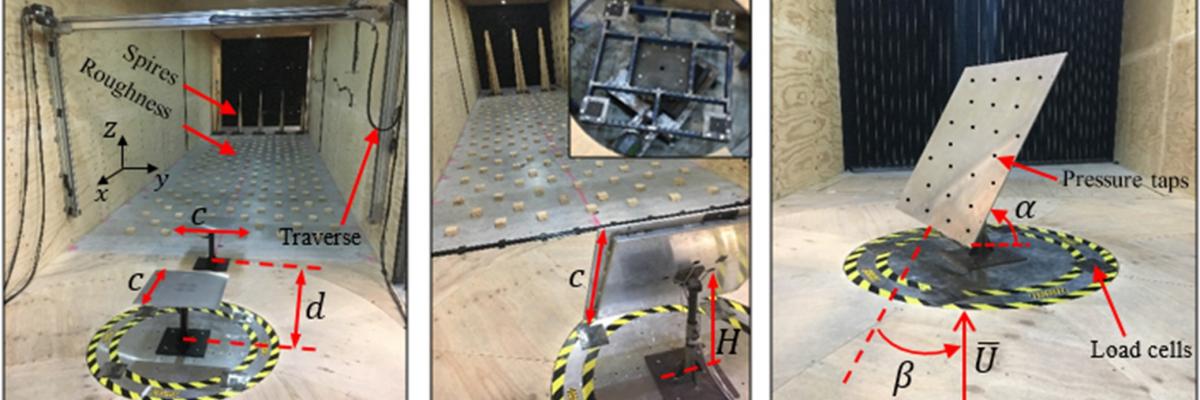
Experimental setup of heliostat models with defined in the atmospheric test section of the University of Adelaide wind tunnel (Arjomandi et al. 2019).
- Base force measurements and pressure distributions on scale-model heliostats
- Square and rectangular heliostat mirrors with chord lengths 0.2 m to 0.8 m and aspect ratios of 1-2
- Telescopic pylon design allowing variation of elevation axis height from 0.15 m to 0.5 m
- Hinge design allows modification of the heliostat elevation angle with respect to the horizontal
- Six-axis load cell mounted in base force balance to measure three component forces (Fx, Fy, Fz) and three component moments (Mx, My, Mz) on a 3 m diameter turntable for modification of the azimuth angle
- Pressure taps on the heliostat surface monitor the non-uniform pressure distributions
- In-house image processing, post-processing and data analysis, including capability to extract derived quantities, such as turbulence intensity, power spectra and integral length scales
The atmospheric boundary layer research facility (ABLRF) has been established at the University of Adelaide Roseworthy campus for field measurements of ABL turbulence and heliostat wind loads. Key components and instrumentation of the ABLRF include:
- A 12-m height cantilevered lattice tower containing five ultrasonic anemometers and five cup anemometers at logarithmically spaced heights above the surface
- A horizontal array of five 3-m height masts with ultrasonic anemometers spanning the crosswind with the prevailing wind direction from the south-west
- A horizontal array of four tripod masts with ultrasonic and cup anemometers in the longitudinal direction of the prevailing wind
- A rectangular heliostat model containing 48 high-frequency (differential) pressure sensors and a six-axis load cell
- Remote heliostat control and data monitoring through cellular networks and a standalone power system consisting of two 315W photovoltaic panels and four 102Ah batteries
Atmospheric Boundary Layer Research Facility (ABLRF) in 50 m × 50 m fenced space at the University of Adelaide Roseworthy campus, including a 12-m lattice tower, longitudinal and crosswind mast arrays containing ultrasonic and cup anemometers, and a heliostat model.
Two WindCube Scan 100S Doppler lidars will be deployed at ABLRF. The lidar system operates using a solid-state, eye-safe laser at a wavelength of 1.54 µm, capable of measuring radial wind speeds with an accuracy of 0.1 m/s. The systems provide flexible spatial resolution down to 25 metres and can measure wind fields at ranges exceeding 6 km.
The dual-lidar configuration at ABLRF opens significant research opportunities, particularly in capturing detailed spatial and temporal variations in wind flow within and above heliostat fields. Potential research topics include quantifying turbulence structures and wake interactions induced by heliostat arrays, evaluating coherent turbulent structures relevant to wind loading, and improving modelling approaches for predicting wind-induced forces on solar energy infrastructure. Furthermore, dual-lidar observations will facilitate validation of computational fluid dynamics simulations, development of site-specific turbulence models, and characterisation of atmospheric stability impacts on wind resource assessments and operational risk for concentrating solar power systems.
-
Research data
Heliostat wind load spreadsheet
Wind load predictions for heliostats are not provided in design codes because of their non-standard shape and the changes in wind velocity and turbulence in the lowest 10 m of the atmospheric boundary layer (ABL). The ASTRI heliostat spreadsheet estimates the design wind loads on different heliostat sizes based on:
(1) the dependence of wind load coefficients on turbulence intensity derived in our wind tunnel experiments,
(2) the expected wind speed and turbulence intensity profiles in the full-scale ABL.
Mean and peak design loads are calculated for a square-shaped heliostat based on the mean wind speed and the relevant aerodynamic coefficient. Critical load cases show the maximum value of the heliostat loads and aerodynamic coefficients for each load case.
-
List of publications
Listed below are the recent publications arising out of the heliostat wind load and aerodynamics research group. Direct links to the published articles (via digital object identifiers, DOIs), or where available, accepted versions of manuscripts, can be found by clicking the hyperlinks below.
Journal articles
Bakhshipour, S., Emes, M. J., Jafari, A., & Arjomandi, M. (2024). Heliostat wind loads: Effects of the aspect ratio and ground clearance ratio. Solar Energy, 269, 112332. DOI: 10.1016/j.solener.2023.112332
Emes, M. J., Marano, M., & Arjomandi, M. (2024). Heliostat wind loads in the atmospheric boundary layer (ABL): Reconciling field measurements with wind tunnel experiments. Solar Energy, 277, 112742-1-112742-14. DOI: http://dx.doi.org/10.1016/j.solener.2024.112742
Emes, M. J., Arjomandi, M., & Leslie, B. (2024). Heliostat wind loads in the atmospheric boundary layer. Solar Energy, 274, 240–250. DOI: 10.1016/j.solener.2023.114350
Marano, M., Emes, M. J., Jafari, A., & Arjomandi, M. (2024). Effect of facet gap on heliostat wind loading. Solar Energy, 271, 112428. DOI: http://dx.doi.org/10.1016/j.solener.2024.112428
Emes, M., Yellapantula, S., Sment, J., Armijo, K., Muller, M., Mehos, M., . . . Arjomandi, M. (2024). Heliostat Consortium: Gap Analysis on State of the Art in Wind Load Design. Journal of Solar Energy Engineering, 146(6), 061001-1-061001-9. DOI: http://dx.doi.org/10.1115/1.4065429
Bakhshipour, S., Emes, M. J., Jafari, A., & Arjomandi, M. (2023). Effects of turbulence intensity on heliostat wind loads in atmospheric boundary layer flow. Solar Energy, 258, 151–165. DOI: 10.1016/j.solener.2023.03.020
Emes, M. J., Marano, M., Leslie, B., & Arjomandi, M. (2023). Extreme value analysis for peak heliostat wind load predictions. Solar Energy, 252, 166–179. DOI: 10.1016/j.solener.2022.11.056
Emes, M. J., Jafari, A., & Arjomandi, M. (2022). A feasibility study on the application of mesh grids for heliostat wind load reduction. Solar Energy, 240, 121–130. DOI: 10.1016/j.solener.2022.03.039
Emes, M. J., Leslie, B., & Arjomandi, M. (2022). Stowing strategy for a heliostat field based on wind speed and direction. AIP Conference Proceedings, 2445(1), 120011. DOI: 10.1063/5.0099622
Emes, M., Jafari, A., and Arjomandi, M. (2022), A feasibility study on the application of mesh grids for heliostat wind load reduction, Solar Energy, 240, 121-130. doi: 10.1016/j.solener.2022.05.033
Emes, M., Jafari, A., Pfahl, A., Coventry, J. and Arjomandi, M. (2021), A review of static and dynamic heliostat wind loads, Solar Energy, 225, 60-82. doi: 10.1016/j.solener.2021.07.014
Jafari, A., Emes, M., Cazzolato, B., Ghanadi, F. and Arjomandi, M. (2021), Wire mesh fences for manipulation of turbulence energy spectrum, Experiments in Fluids, 62(2), 30. doi: 10.1007/s00348-021-03133-7
Emes, M.J., Jafari, A., Coventry, J. and Arjomandi, M. (2020), The influence of atmospheric boundary layer turbulence on the design wind loads and cost of heliostats, Solar Energy, 207, 796-812. doi:10.1016/j.solener.2020.07.022
Jafari, A., Emes, M., Cazzolato, B., Ghanadi, F. and Arjomandi, M. (2020), Turbulence characteristics in the wake of a heliostat in an atmospheric boundary layer flow, Physics of Fluids, 32(4), 045116. doi:10.1063/5.0005594
Emes, M.J., Arjomandi, M., Kelso, R.M. and Ghanadi, F. (2019), Turbulence length scales in a low-roughness near-neutral atmospheric surface layer, Journal of Turbulence, 20:9, 545-562. doi:10.1080/14685248.2019.1677908
Emes, M.J., Jafari, A., Ghanadi, F. and Arjomandi, M. (2019), Hinge and overturning moments due to unsteady heliostat pressure distributions in a turbulent atmospheric boundary layer, Solar Energy, 193, 604-617. doi:10.1016/j.solener.2019.09.097
Jafari, A., Ghanadi, F., Emes, M.J., Arjomandi, M. and Cazzolato, B.S. (2019), Measurement of unsteady wind loads in a wind tunnel: scaling of turbulence spectra, Journal of Wind Engineering and Industrial Aerodynamics, 193, 103955. doi:10.1016/j.jweia.2019.103955
Jafari, A., Ghanadi, F., Arjomandi, M., Emes, M. & Cazzolato, B. (2019). Correlating turbulence intensity and length scale with the unsteady lift force on flat plates in an atmospheric boundary layer flow. Journal of Wind Engineering and Industrial Aerodynamics, 189, 218-230. doi:10.1016/j.jweia.2019.03.029
Yu, J., Emes, M., Ghanadi, F., Arjomandi, M. & Kelso, R. (2019). Experimental investigation of peak wind loads on tandem operating heliostats within an atmospheric boundary layer. Solar Energy, 183, 248-259. doi:10.1016/j.solener.2019.03.002
Emes, M., Ghanadi, F., Arjomandi, M., & Kelso, R. (2018). Investigation of peak wind loads on tandem heliostats in stow position. Renewable Energy, 121, 548-558. doi:10.1016/j.renene.2018.01.080
Emes, M., Arjomandi, M., Ghanadi, F., & Kelso, R. (2017). Effect of turbulence characteristics in the atmospheric surface layer on the peak wind loads on heliostats in stow position. Solar Energy, 157, 284-297. doi:10.1016/j.solener.2017.08.031
Emes, M., Arjomandi, M., & Nathan, G. (2015). Effect of heliostat design wind speed on the levelised cost of electricity from concentrating solar thermal power tower plants. Solar Energy, 115, 441-451. doi:10.1016/j.solener.2015.02.047
Conference papers
Marano, M., Emes, M., Jafari, A., & Arjomandi, M. (2023). Heliostat Wind Load Field Measurements at the University of Adelaide Atmospheric Boundary Layer Research Facility (ABLRF). SOLARPACES 2022, 28TH INTERNATIONAL CONFERENCE ON CONCENTRATING SOLAR POWER AND CHEMICAL ENERGY SYSTEMS, 1, 8 pages. DOI: http://dx.doi.org/10.52825/solarpaces.v1i.670
Marano, M., Ernes, M., Jafaril, A., & Arjomandi, M. (2023). Variation of Heliostat Wind Loads in a Radial Field Array Model. SOLARPACES 2023, 29TH INTERNATIONAL CONFERENCE ON CONCENTRATING SOLAR POWER, THERMAL, AND CHEMICAL ENERGY SYSTEMS, 2, 8 pages. DOI: http://dx.doi.org/10.52825/solarpaces.v2i.841
Jafari, A., Emes, M. J., & Arjomandi, M. (2023). Impact of Atmospheric Turbulence on Dynamic Wind Loads on Heliostats. SOLARPACES 2023, 29TH INTERNATIONAL CONFERENCE ON CONCENTRATING SOLAR POWER, THERMAL, AND CHEMICAL ENERGY SYSTEMS, 2, 9 pages. DOI: http://dx.doi.org/10.52825/solarpaces.v2i.835
Emes, M. J., Leslie, B., & Arjomandi, M. (2022). Stowing strategy for a heliostat field based on wind speed and direction.AIP Conference Proceedings, 2445(1), 120011. DOI: 10.1063/5.0099622
Emes, M. J., Marano, M., Leslie, B., & Arjomandi, M. (2022). Extreme value analysis for peak heliostat wind load predictions. SolarPACES 2022, Albuquerque, New Mexico, USA.
Emes, M. J., Marano, M., Leslie, B., & Arjomandi, M. (2022). Heliostat wind load field measurements at the Atmospheric Boundary Layer Research Facility (ABLRF). SolarPACES 2022, Albuquerque, New Mexico, USA.
Emes, M., Jafari, A., Collins, M., Wilbert, S., Zarzalejo, L., Siegrist, S. and Arjomandi, M. (2022), Stowing strategy for a heliostat field based on wind speed and direction, AIP Conference Proceedings, 2445(1), 120011. doi: 10.1063/5.0085677
Emes, M.J., Jafari, A. & Arjomandi, M., Wind Load Design Considerations for the Elevation and Azimuth Drives of a Heliostat, in SolarPACES, 2019, AIP Conference Proceedings: Daegu, 2303, 030013. doi:10.1063/5.0028609
Jafari, A., Emes, M., Cazzolato, B., Ghanadi, F. and Arjomandi, M., An Experimental investigation of unsteady pressure distribution on tandem heliostats, in SolarPACES, 2019, AIP Conference Proceedings: Daegu, 2303, 030022. doi:10.1063/5.0028678
Arjomandi, M., Emes, M., Jafari, A., Yu, J., Ghanadi, F., Kelso, R., Cazzolato, B., Coventry, J. and Collins, M., A Summary of Experimental Studies on Heliostat Wind Loads in a Turbulent Atmospheric Boundary Layer, in SolarPACES, 2019, AIP Conference Proceedings: Daegu, 2303, 030003. doi:10.1063/5.0028676
Emes, M.J., Jafari, A., Ghanadi, F. and Arjomandi, M. (2019), A method for the calculation of the design wind loads on heliostats, AIP Conference Proceedings: Casablanca, 2126(1), 030020. doi:10.1063/1.5117532
Jafari, A., Ghanadi, F., Emes, M., Arjomandi, M. & Cazzolato, B. (2018). Effect of Free-stream Turbulence on the Drag Force on a Flat Plate. In Proceedings of the 21st Australasian Fluid Mechanics Conference. Adelaide, Australia.
Emes, M., Jafari, A. & Arjomandi, M. (2018). Estimating the Turbulence Length Scales from Cross-Correlation Measurements in the Atmospheric Surface Layer. In Proceedings of the 21st Australasian Fluid Mechanics Conference. Adelaide, Australia.
Emes, M., Yu, J., Jafari, A., Ghanadi, F., & Arjomandi, M. (2017). Experimental Investigation of the Wind Loads on Heliostats. In Proceedings of the Asia Pacific Solar Research Conference 2017. Melbourne, Australia: Australian PV Institute. Retrieved from http://apvi.org.au/solar-research-conference/proceedings-apsrc-2017/
Jafari, A., Emes, M., Ghanadi, F., & Arjomandi, M. (2017). The Effect of Turbulence Intensity on the Peak Wind Loads on Heliostats. In Proceedings of the Asia Pacific Solar Research Conference 2017. Melbourne, Australia: Australian PV Institute. Retrieved from http://apvi.org.au/solar-research-conference/proceedings-apsrc-2017/ Voluptatem accusantium doloremque
Emes, M. J., Ghanadi, F., Arjomandi, M., & Kelso, R. M. (2017). Optimisation of the size and cost of heliostats in a concentrating solar thermal power tower plant. In The European Conference on Sustainability, Energy & the Environment 2017. Brighton, UK. Retrieved from https://papers.iafor.org/submission36612/
Ghanadi, F., Emes, M., Yu, J., Arjomandi, M., & Kelso, R. (2017). Investigation of the atmospheric boundary layer characteristics on gust factor for the calculation of wind load. In AIP Conference Proceedings Vol. 1850. doi:10.1063/1.4984496
Ghanadi, F., Yu, J., Emes, M., Arjomandi, M., & Kelso, R. (2017). Numerical investigation of wind loads on an operating heliostat. In AIP Conference Proceedings Vol. 1850. doi:10.1063/1.4984497
Emes, M. J., Arjomandi, M., Ghanadi, F., & Kelso, R. M. (2017). Wind tunnel investigation of turbulence characteristics in the atmospheric surface layer. In Wind Energy Science Conference. Copenhagen, Denmark.
Emes, M., Ghanadi, F., Arjomandi, M., & Kelso, R. (2016). An experimental technique for the generation of large-scale spanwise vortices in a wind tunnel. In Proceedings of the 20th Australasian Fluid Mechanics Conference (pp. 1-5). Perth, Australia: Australasian Fluid Mechanics Society.
Emes, M., Arjomandi, M., Kelso, R., & Ghanadi, F. (2016). Integral length scales in a low-roughness atmospheric boundary layer. In Proceedings of the 18th Australasian Wind Engineering Society Workshop (pp. 1-4). McLaren Vale, South Australia: AWES.
Coventry, J., Arjomandi, M., Barry, J., Blanco, M., Burgess, G., Campbell, J., Emes, M., . . . Yu, J. (2016). Development of the ASTRI heliostat. In V. Rajpaul, & C. Richter (Eds.), Proceedings of International Conference on Concentrating Solar Power and Chemical Energy Systems, as published in AIP Conference Proceedings Vol. 1734 (pp. 020005-1-020005-8). Cape Town, South Africa: American Institute of Physics. doi:10.1063/1.4949029
-
Contact us

